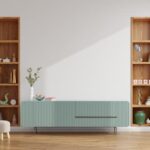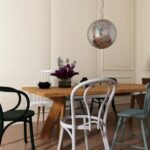A split level home is an architectural style that offers a distinct and unique layout, but it can also present challenges when it comes to decorating. In this article, we will explore the concept of a split level home and delve into its design and layout challenges.
Understanding the different levels of a split level home is crucial in order to utilize each area effectively for different purposes. We will discuss how to maintain a seamless flow between the various levels using color schemes, furniture placement, and lighting.
Additionally, we will provide tips on creating distinct zones within each level of the home and maximizing space through creative ideas and space-saving solutions. Finally, we will address common challenges presented by split level homes such as low ceilings and awkward spaces while exploring ways to overcome them.
Whether you’re planning to renovate your existing split level home or are interested in purchasing one, this article will provide you with valuable insights on how to decorate and design it successfully.
Understanding the different levels
Understanding the different levels of a split level home is crucial in order to effectively utilize the space and create a cohesive design. Split level homes are characterized by having multiple levels that are staggered, creating unique challenges when it comes to decor and layout. By breaking down the different levels – the main level, upper level, and lower level – homeowners can better understand how each area can be utilized for different purposes.
The main level of a split level home is typically where you will find the entryway, living room, dining room, and kitchen. This area is usually open and connected, allowing for easy flow between the spaces. When decorating this level, it’s important to maintain a cohesive color scheme and choose furniture that complements each other. To emphasize the natural flow between these areas, consider using neutral colors or tones that transition well from one space to another.
Moving up to the upper level of a split level home, you will often find bedrooms and bathrooms. This area provides privacy and serves as a retreat from the main living spaces. When designing this level, focus on creating a serene and comfortable atmosphere. Consider using soft colors in bedrooms and adding cozy textures like rugs or throws. Additionally, incorporating built-in storage solutions can help maximize space and keep the area organized.
The lower level of a split-level home often contains additional living spaces such as a family room or entertainment area. This area is perfect for casual gatherings or as an extension of the main living areas. When designing this space, think about creating distinct zones based on their functions. For example, you can create an entertainment area with comfortable seating and a media center or designate an area specifically for children with games or toys.
| Main Level | Upper Level | Lower Level |
|---|---|---|
| Living room, dining room, kitchen | Bedrooms, bathrooms | Family room, entertainment area |
| Maintain cohesive color scheme and furniture placement | Create a serene and comfortable atmosphere | Create distinct zones based on functions |
| Focus on natural flow between spaces | Incorporate built-in storage solutions for organization | Consider an entertainment area or designated children’s space |
Emphasizing the natural flow
Choosing a cohesive color scheme
One of the key elements in maintaining a seamless flow between the different levels of a split level home is choosing a cohesive color scheme. By using consistent colors throughout the house, you can create a sense of unity and harmony. Start by selecting a main color palette that complements the overall style and design of your home.
This palette can then be used as a guide for selecting paint colors, furniture upholstery, and accessories throughout the different levels. Consider using lighter shades for smaller areas to create an illusion of space, and darker shades in larger spaces for added drama.
Furniture placement for continuity
Proper furniture placement is essential for maintaining a natural flow between the different levels of a split level home. Start by considering the sight lines and orientations of each level. Arrange furniture in a way that allows for easy movement between spaces, avoiding any obstructions or barriers that could disrupt the flow.
Use area rugs to visually connect adjoining areas and anchor furniture groupings. Additionally, consider using versatile furniture pieces that can serve multiple purposes to maximize functionality without overwhelming the space.
Lighting considerations for seamless transitions
Effective lighting plays a crucial role in accentuating the natural flow between different levels of your split level home. Aim to achieve balanced lighting throughout each level by combining general overhead lighting with task lighting and ambient lighting. Installing recessed or track lighting can help illuminate hallways and transition areas, while pendant lights or chandeliers can add character to larger open spaces such as living rooms or dining areas.
Incorporating natural light is also important in achieving visual connectivity between levels. Consider installing skylights or large windows where feasible to enhance the sense of openness and bring more natural light into your home.
By carefully considering your color scheme, thoughtfully placing furniture, and implementing appropriate lighting strategies, you can maintain a seamless flow between the different levels of your split level home. This will create a visually appealing and cohesive space that feels harmonious and inviting throughout all areas of the house.
Creating distinct zones
Creating distinct zones within each level of a split level home is essential for maximizing the functionality and design of the space. By creating distinct zones, you can ensure that each area serves a specific purpose and contributes to the overall flow and organization of your home. Whether you want to create a cozy reading corner, a dedicated home office, or an entertainment area, there are several strategies you can employ to achieve this.
One effective way to create distinct zones within each level is through furniture arrangement. Consider using rugs or different flooring materials to define separate areas within an open concept layout. Additionally, strategically placing furniture pieces such as bookshelves or room dividers can help visually separate spaces while still maintaining an open and cohesive feel.
Another way to create distinct zones is through the use of color schemes and lighting. Using different colors or patterns on walls or by incorporating accent walls can visually divide spaces and indicate their intended purpose. Lighting plays a crucial role in creating ambiance and highlighting specific areas within each zone. Consider using task lighting for functional areas such as desks or reading corners, while using softer ambient lighting for relaxation areas.
Utilizing built-in storage solutions can also help create distinct zones by providing designated spaces for different activities. Built-in shelving units can serve as partitions between areas while providing storage for books, decor items, or work materials. Utilizing vertical space effectively can also help maximize storage options and contribute to the overall organization of your split level home.
In summary, creating distinct zones within each level of a split level home is essential for maximizing functionality and organization. By employing strategies such as furniture arrangement, color schemes, lighting, and built-in storage solutions, you can create separate areas that serve specific functions while maintaining a cohesive overall design aesthetic.
Maximizing space
Utilizing Under-Stair Storage
One of the key strategies for maximizing space in a split level home is to utilize the often-overlooked area underneath the stairs. This can be a valuable storage space for items such as shoes, backpacks, or seasonal decorations. Consider installing custom-built cabinets or shelves that fit seamlessly into the under-stair area.
Alternatively, you can opt for pre-fabricated storage units specifically designed for this purpose. These units come in various sizes and configurations, making it easy to find one that suits your needs and matches the overall style of your home.
Incorporating Built-In Shelving
Another effective way to optimize each level of your split level home is by incorporating built-in shelving. This not only adds extra storage space but also adds visual interest to your interior design. Consider installing built-in shelves along walls in areas such as the living room, study area, or even the stairwell.
These shelves can be used to display books, photographs, decorative objects, or even incorporate plants for a touch of greenery. Built-in shelving can be customized to fit any space and can make use of otherwise vacant walls.
Utilizing Vertical Space
When dealing with limited square footage in a split level home, it’s essential to make use of vertical space efficiently. Look for creative solutions such as ceiling-mounted storage racks or hanging organizers that utilize unused wall space. Vertical storage options can be utilized in various areas including kitchens, bathrooms, closets, and garages. In addition to providing extra storage space, these solutions also help keep clutter off surfaces and maximize available floor space.
By employing under-stair storage solutions, incorporating built-in shelving systems, and utilizing vertical spaces effectively throughout each level of your split level home, you can create functional and organized spaces that optimize every square inch of your property while maintaining a cohesive and visually appealing design.
Enhancing connectivity
In a split level home, it is crucial to create a sense of visual and physical connectivity between the different levels. This helps to eliminate any feelings of disjointedness and creates a harmonious flow throughout the space. One effective way to achieve this is through open floor plans. By removing unnecessary walls or partitioning, you can create an open and spacious feel that allows you to move seamlessly between levels.
Strategically placing furniture can also enhance connectivity in a split level home. When arranging your furniture, consider the flow of traffic and ensure that there are clear pathways connecting each level. Placing furniture in a way that allows for easy movement naturally creates a sense of connection between areas.
Additionally, using multi-functional furniture pieces can help save space while still maintaining an open feel. For example, incorporating wall-mounted shelving units with built-in desks or using modular sofas that can be rearranged to fit different spaces.
Another way to enhance connectivity is through the use of architectural features. Highlighting architectural details like staircases or exposed beams not only adds character to your split level home but also serves as a visual connection between the various levels. Consider painting or staining these elements in cohesive colors that complement the overall design scheme of your home. Additionally, utilizing windows strategically can bring in natural light and improve connectivity by visually connecting indoor and outdoor spaces.
To summarize:
- Create an open floor plan by removing unnecessary walls or partitions.
- Strategically place furniture to create clear pathways and promote easy movement.
- Highlight architectural features such as staircases and expose beams to visually connect different levels.
By implementing these strategies, you can enhance both the visual and physical connectivity between the different levels of your split level home, creating a cohesive and inviting living space.
Incorporating personal style
When it comes to decorating a split level home, incorporating personal style is key to creating a space that truly feels like your own. By selecting furniture, color palettes, and accessories that reflect your unique taste and preferences, you can infuse your personality into every corner of your home. Here are some guidance on how to achieve this:
- Select furniture that speaks to your style: Start by choosing furniture pieces that align with your preferred design aesthetic. Whether you lean towards modern minimalism or eclectic bohemian, there are endless options available. Consider the scale and proportion of the furniture in relation to the size of each level in order to create a harmonious balance.
- Play with color palettes: Color has a powerful impact on the overall vibe and mood of a space. Decide on a color palette that evokes the atmosphere you want to create within each level of your split level home. Experiment with different shades and tones, but ensure that they flow seamlessly from one area to another.
- Accessorize thoughtfully: Accessories are an excellent way to add personality and character to any space. Choose items that resonate with you personally, such as artwork, photographs, decorative objects, or plants. Mix and match textures and patterns for added visual interest.
Incorporating personal style into the decor of a split level home allows you to create a space that truly feels like yours. By selecting furniture, color palettes, and accessories that reflect your unique taste and preferences, you can infuse your personality throughout each level of your home. Remember to choose furniture pieces that align with your preferred design aesthetic by considering their scale in relation to each level’s size.
Play around with different color palettes that evoke the atmosphere you want to create within each area of your home. Finally, accessorize thoughtfully by choosing items that resonate with you personally and mix textures and patterns for added visual interest.
Dealing with challenging areas
Addressing the unique challenges presented by split level homes is crucial in creating a well-designed and functional space. One common challenge is dealing with low ceilings, which can make a room feel cramped and claustrophobic. To overcome this obstacle, it’s important to use techniques that create the illusion of height.
Choosing a light color palette for walls and ceilings can help reflect more natural light and make the space feel larger. Avoiding heavy drapes and instead opting for sheer curtains or blinds can also help maximize the amount of light coming into the room.
Tight hallways are another common challenge in split level homes. These narrow spaces can often feel cramped and closed off. To make them appear larger and more open, consider using light-colored paint on the walls, as well as adding mirrors or artwork to visually expand the space. Additionally, utilizing lighting fixtures such as wall sconces or track lighting can help brighten up these narrow hallways and draw attention away from their size.
Awkward spaces, such as under stairs or sloping walls, are another challenge that may arise in split level homes. However, these areas can be turned into unique and functional spaces with some creativity. Consider transforming under-stair areas into storage solutions or cozy reading nooks by adding built-in shelving or seating options. Sloping walls can be highlighted by placing shelves or artwork strategically to draw attention to their unique shape.
Incorporating these solution-oriented ideas will help you overcome the challenges presented by split level homes. Remember to keep an open mind when designing these spaces and think outside of the box to maximize their potential functionality while still maintaining your personal style throughout your home decor choices.
Lighting and ambiance
In a split level home, the right lighting can make all the difference in enhancing its unique architectural features and creating ambiance throughout the different levels. When it comes to lighting and ambiance, there are various options to consider that can highlight specific areas and add a warm, inviting atmosphere to your home.
One popular choice for adding visual interest and drama to a split level home is pendant lights. These hanging fixtures not only provide ample light but also serve as statement pieces that can draw attention to high ceilings or focal points in the living area. For example, placing a cluster of pendant lights above a dining table or kitchen island can create a striking visual element while illuminating these functional spaces.
Recessed lighting is another effective option for split level homes. This type of lighting is installed directly into the ceiling, providing a clean and streamlined look. By strategically placing recessed lights throughout the different levels of your home, you can create even lighting that properly illuminates each area without interfering with the flow of the space. Additionally, recessed lighting can be combined with dimmer switches to adjust the brightness according to your needs or desired ambiance.
Floor lamps are versatile lighting fixtures that can be used in various areas of a split level home. They provide both ambient and task lighting while adding an element of style to any room. Floor lamps work well in corners or alcoves where overhead lighting may not reach, effectively brightening up these often overlooked areas. They also come in a wide variety of designs, allowing you to choose one that complements your personal style while adding extra illumination.
By exploring various lighting options such as pendant lights, recessed lighting, and floor lamps, you can transform your split level home into an inviting oasis with enhanced architectural features and carefully crafted ambiance. Experiment with different placements and wattages to find the perfect combination of light sources that will improve both functionality and aesthetics within each specific area of your home.
Remember, proper lighting has the power to enhance the overall design of your split level home and highlight its unique characteristics.
Conclusion
In conclusion, decorating a split level home requires careful consideration and planning to optimize the unique design and layout challenges. Throughout this article, we have explored various strategies to make the most of each level, create distinct zones, enhance connectivity, incorporate personal style, and overcome common obstacles presented by split level homes.
By understanding the different levels of a split level home, homeowners can effectively utilize each area for different purposes. Whether it’s transforming the main level into a welcoming gathering space or creating a dedicated home office in the upper level, maximizing space is essential. Utilizing creative ideas such as under-stair storage and built-in shelving can help make the most of every square foot.
Maintaining a seamless flow between the different levels is crucial in creating an inviting and cohesive atmosphere. Tips such as using color schemes, thoughtful furniture placement, and strategic lighting can help achieve this goal. Additionally, by enhancing connectivity through open floor plans and architectural features, homeowners can ensure that their split level home feels harmonious throughout.
When it comes to infusing personal style into the décor of a split level home, selecting furniture, color palettes, and accessories that reflect individual taste is key. By incorporating elements that resonate with the homeowner’s preferences, the home becomes a true reflection of their personality.
Lastly, addressing challenging areas like low ceilings or awkward spaces requires out-of-the-box thinking. By utilizing appropriate lighting options such as pendant lights or recessed lighting to highlight architectural features and create ambiance within these areas can help transform them into functional spaces.
Frequently Asked Questions
How can I make my split-level house look better?
To make a split-level house look better, there are several things you can do. First, consider updating the exterior by giving it a fresh coat of paint and enhancing the landscaping with colorful flowers or shrubs. Adding architectural elements such as shutters, window boxes, or decorative trim can also enhance the visual appeal.
Inside, focus on maximizing natural light by using sheer curtains or blinds that allow sunlight to filter in. Consider removing any unnecessary walls to create an open floor plan and improve the flow between rooms. Updating the flooring, adding modern lighting fixtures, and choosing a cohesive color scheme throughout the house can also make a significant difference in improving its overall appearance.
How do you add value to a split-level house?
Adding value to a split-level house involves making strategic updates and renovations that appeal to potential buyers or renters. Start by focusing on improving the curb appeal as this is the first thing people notice when they approach your property. Enhancing landscaping, repainting exterior surfaces, and replacing outdated doors or windows can significantly increase its value.
Inside, consider renovating key areas such as the kitchen and bathrooms which generally have a high return on investment. Upgrading appliances, countertops, cabinets, and fixtures not only add functionality but also a modern touch to these spaces. Additionally, enhancing energy efficiency features like insulation, windows, or HVAC systems can be attractive to buyers who prioritize sustainability.
How do you modernize the exterior of a split-level?
Modernizing the exterior of a split-level house involves updating key design elements while maintaining its unique architectural style. One way to achieve this is by giving it a fresh coat of paint in contemporary colors that complement each other well and suit your aesthetic preferences. Consider replacing old siding with newer materials like fiber cement board or vinyl that offer improved durability with minimal maintenance requirements.
Updating windows with sleek frames can give your home a more modern appearance while increasing energy efficiency. Another option is to add architectural details such as stone veneer accents or metal cladding that provide texture and visual interest to the exterior. Additionally, updating the entryway with a modern front door and contemporary lighting fixtures can transform the overall look of the house.

I’m thrilled to be your companion on this exciting journey through the world of home decor and design. With a passion for turning houses into homes and a keen eye for the finer details, I’m here to help you transform your living spaces into beautiful, functional, and meaningful havens.





